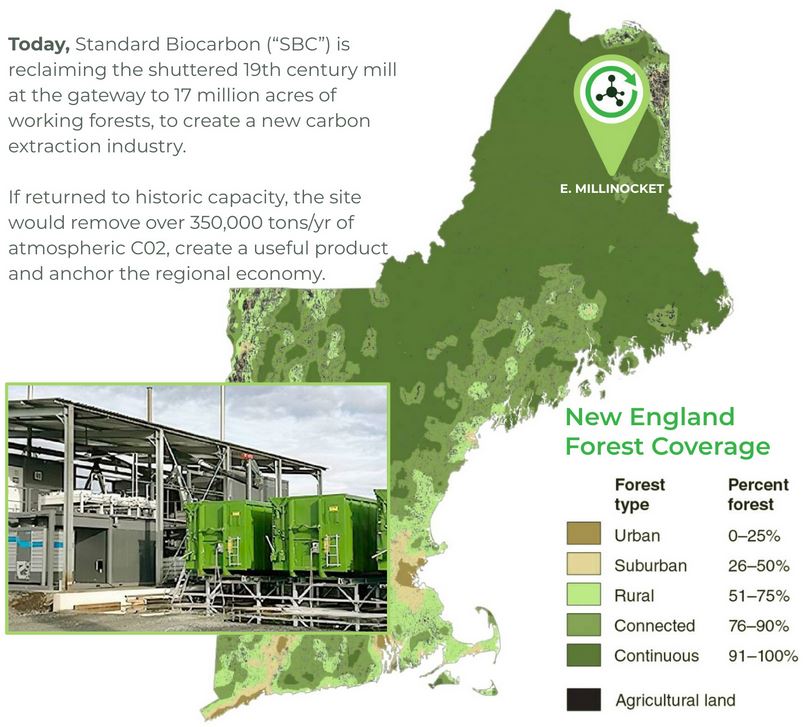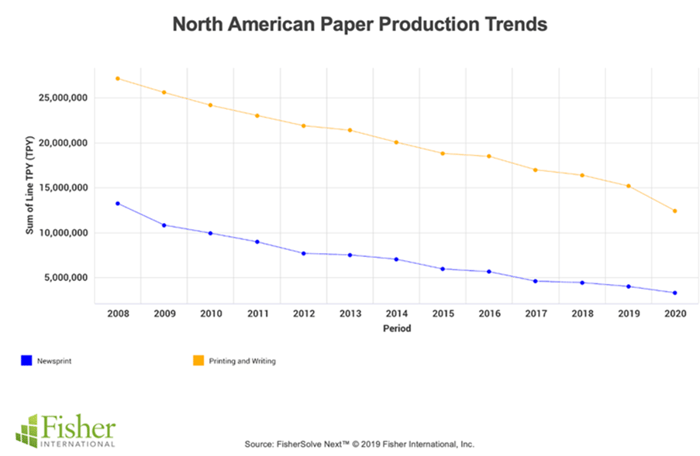5 min read
Innovative Maine Project Will Create Sustainable Demand for Forest Products
John Greene
:
April 20, 2021

When it comes to the issue of managing forests, environmental and economic concerns oftentimes seem incompatible to those unfamiliar with forestry and silvicultural practices. The idea of managing America’s forests for the production of wood raw materials might seem antiquated to those who approach this subject believing there is either one advantage or the other, but not both.
This simply isn’t true. As Forest2Market has demonstrated through the important work undertaken with our industry partners, working forests impart tremendous economic and environmental benefits to us all that span generations.
Further, to fully embrace the philosophical objectives behind the modern “circular economy” is to recognize the symbiotic relationship that can exist between sustainably managed natural resources and the markets that rely on them. Maintaining proper balance in this relationship is imperative for the long-term success of both concerns.
In a piece we recently published on the economics of pulpwood supply, we demonstrated why new markets for low-value wood products are essential for keeping forestlands forested. When forestland ownership becomes uneconomical, the risk for converting the land to other uses increases and with such conversion, the forest is lost forever. Therefore, keeping the economics of forest ownership strong is a key component in preserving the proven relationship between environmental and economic interests of the forest.
Regional Challenges
In the Northeastern US, this relationship between industry and the region’s wood resources has been in a variable state of imbalance for the last 20+ years. With its high concentration of pulp & paper mills – particularly printing & writing papers – the Northeast has seen dozens of longstanding mills curtail production or shutter altogether as consumer habits have changed. The rise of digital media has supplanted demand for paper media formats, and the trend has resulted in a structural change to this segment across the North American forest products industry.
- Demand for printing and writing papers is declining 6% annually and is expected to continue.
- In 2017 alone, newsprint demand was down 10% from the previous year.
- Recent demand trends for boxboard and liquid packaging have also been flat to decreasing, resulting in a 25% decrease in hardwood fiber demand over the past 10 years and expectations are that this market will continue to evaporate.

It's also no surprise that the COVID-19 pandemic has accelerated the decline of the printing & writing papers segment; the tens of millions of students and employees who have been confined to their homes for the better part of the last year have had little need for many of the products that span the P&W segment.
While the surge in e-commerce has increased demand for packaging and shipping boxes, and the strong housing sector has strained lumber manufacturers in recent months, these products are increasingly manufactured from the more economical, fast-growing softwood resources in the US South. As a result, forestland owners in the Northeast have witnessed once-stable outlets for their timber resources vanish one by one, and demand dwindles further by the year. Since 2014, Maine alone has lost market for over 4 million tons of low-grade wood that would have otherwise supplied paper and biomass mills. In a region hamstrung by high costs and shrinking demand, landowners have few options to maintain the balance that help to keep their forestlands forested.
Are Maine’s Forest Resources Sustainable?
The decrease in demand for forest products in Maine has skewed the balance between its markets and forest resources. In fact, this ongoing trend suggests that Maine’s forest resources are at risk of being underutilized as the growth of forest inventory outpaces removals.
The most precise method to gauge the balance of tree growth and removals is to analyze the growth-to-removal ratio (GRR), which reflects the interplay between these two metrics in a supply basin. As an indicator of the trajectory of available supply over time (not a snapshot of availability at a moment in time), a GRR calculation quantifies overall forest sustainability.
A value of 1.0 suggests growth and removals are in balance; a value greater than 1.0 means forest inventory growth is outpacing removals (greater sustainability), and a value lower than 1.0 means removals are outpacing growth (lower sustainability). For example, a GRR of 1.33 means that growth outpaced removals by 33%, whereas a GRR of 0.95 means that removals outpaced growth by 5%. Adjusting for land-use changes, studies have shown GRR in a region tends to be cyclical over long periods of time as market forces react to high or low ratios that then move back toward equilibrium.
The growth-to-removal ratio on Maine’s timberlands is 1.27, which means tree growth is outpacing removals by 27%. Therefore, Maine’s forests have an excess of available supply to accommodate the needs of its regional forest products industry.
Defining the Circular Economy
Economic models that nurture the development of “circular economics” are all the rage in 2021 and while the wording is catchy, the objective is straightforward. Per the Ellen Macarthur Foundation, a UK-based non-profit working with business and policy leaders to promote circular economics, “A circular economy is a systemic approach to economic development designed to benefit businesses, society, and the environment. In contrast to the ‘take-make-waste’ linear model, a circular economy is regenerative by design and aims to gradually decouple growth from the consumption of finite resources.”
Very few businesses exemplify this model more effectively than a sustainably managed forest-based business – especially one that can repurpose manufacturing assets and “drop in” to an existing value chain.
Enter Standard Biocarbon.
In late 2020, Maine-based Standard Biocarbon signed a letter of intent to establish a new forest business at the former Great Northern paper mill site in East Millinocket that was established in the 19th century. The repurposed plant will use low-grade wood traditionally utilized by Maine’s pulp & paper and wood biomass industries to produce biocarbon, which is commercially known as “biochar” and used as a soil amendment in agricultural and environmental applications.
With properties similar to activated carbon, biochar improves soil productivity, reduces irrigation and fertilizer needs and, because it binds with heavy metals and other soil and water contaminants, can be used in environmental clean-up applications. Biochar is also used as a feed additive and in litter to improve animal health and reduce emissions, as well as a cement additive in composite building materials.
Standard Biocarbon’s manufacturing process will also permanently remove carbon from the atmosphere that would otherwise be released through combustion or decomposition of woody biomass. Biocarbon is chemically stable and endures for hundreds of years in the soil. One ton of biocarbon locked into the soil equates to about 3.5 tons of carbon dioxide permanently removed from the atmosphere.
Fred Horton, President and CEO of Standard Biocarbon, notes that "Biocarbon extraction from wood offers a new and viable means to sustainably use Maine’s vast working forests and wood products infrastructure to grow Maine’s economy, and create jobs in an environmentally friendly manner.”
Learn more about the environmental benefits of biochar:
The new project will bring a number of regional benefits, which dovetail neatly with the sustainable objectives of circular economics:
- Optimal access to a vast wood basket of over 17 million acres of sustainable, working forest
- Local, experienced workforce that knows:
- Complex mills and equipment
- Forest industry supply chain dynamics
- Existing hydro power to run facility
- Natural flexibility for expansion
- Strong local, county and state support
Another benefit of repurposing the shuttered Great Northern mill site is strategic access to an established supply chain and the ability to scale rapidly. Thus far, the biochar market has been small and fragmented. A small facility that relies on forest thinnings or waste wood may fill demand gaps in local markets, but Horton envisions a process that can really define the commercial biocarbon market at scale to better manage costs.
For a recent article from New Hampshire’s Granite Geek, Horton said: “I originally said we’ll use waste wood: after a big ice storm, trees fall down, we’ll get them to pay us to take it away to avoid tipping fees. I went down that rabbit hole but it doesn’t work. There’s not nearly enough of it to make a difference; the chips are too inconsistent, and you run out of them. I went down the waste disposal model – sewage sludge – but that doesn’t work. Corn stalks, too. None of those models work, they’ll never make money, they’ll never scale.”
As Eric Kingsley wrote last year, “For better or worse, the forest industry is accustomed to boom-and-bust cycles and is experienced in handling them. Northeast markets are incredibly well-positioned compared to other parts of the country and the forest resources and supply infrastructure is incomparable to other regions. In addition, the region’s consumers live in close proximity to Northeast timber markets.”
Creating new demand for Maine’s low-value wood from its working forests is imperative for maintaining environmental balance and keeping the state’s forests intact. Standard Biocarbon is pioneering a new forest industry in an old forest market - lighting the way for the continued evolution of the region’s forest value chain.
For Maine’s landowners who have made the long-term investments necessary to maintain their forest land base, Standard Biocarbon will open up new markets for their timber. In a dynamic economy, such outlets are imperative to ensuring the long-term viability of managed timberland. It is this symbiotic relationship that incents timberland owners to keep forestlands forested, which provides economic benefits to the owner, and environmental benefits to all of us.





